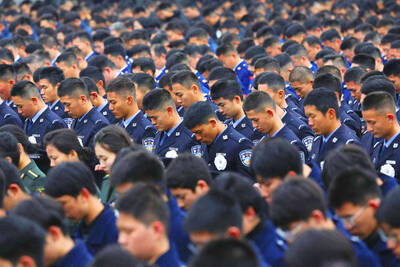The heavy clank of machinery rings out across a seemingly deserted Outback mine site as an invisible satellite signal fires Rio Tinto’s production line into motion.
Massive stackers and reclaimers begin the task of sifting through rust-colored piles of rich iron ore, readying them for the rail journey hundreds of kilometers from mine to port.
It’s an industrious scene — with hardly a living being in sight.
“People frequently ask whether we have anyone working here at all,” one miner at Rio’s Dampier operations said.
“Due to automation and stuff most people are pretty well tucked away from the heat. There’s not a lot of manual workers,” he said.
Automation has long been a part of the mining industry, but advances in satellite, motion-sensor technology and robotics have made the stuff of science fiction a fact of everyday life.
Machines that scoop the ore, dump it on a conveyor belt and hose it down are now controlled from the air-conditioned comfort of Rio Tinto’s Perth operations center, 1,500km from the mine pit.
Hundreds of specially trained operators who once directed machines from on-site offices watch and direct the action from afar using satellite technology, with surveillance cameras feeding into some 440 monitors.
Once fully operational — currently scheduled for June — the operations center will allow all of Rio’s rail, mine and port systems to be coordinated from one place.
Anglo-Australian miner Rio Tinto is one of the world’s biggest mining companies, with aluminum, copper, diamonds, gold and iron ore among its major products.
“Process plants have long been managed from a console — it’s just as if this task is now performed with a much, much longer extension cord,” Rio said in its latest innovations update.
“But never before, on anything like this scale, has the huge number of tasks been accomplished in full view and full knowledge of everyone else involved,” it said.
The operations center in Perth is central to Rio’s “Mine of the Future” program, which aims for driverless trucks and trains, and sensor-fitted “smart drills” that can be operated remotely.
Since December 2008 it has been trying automation technologies at a test site called “A-Pit,” where robotic trucks with artificial intelligence “learn” the layout of the mine and use sensors to sense and avoid obstacles.
Australian government scientists are working closely with the mining industry, drawing inspiration from space exploration to troubleshoot, researcher Ian Gipps said.
“It sounds crazy but quite a few of the problems in space and in remote mining can be similar,” said Gipps, from the Commonwealth Scientific and Industrial Research Organization,
“You don’t necessarily want to have people there … so a lot of exploration on planets requires automated and remote operating systems, particularly automated,” he said.
Current research was focusing on the use of robots fixed with radar and light-spectrum technology to detect and gauge the quality of minerals, he said. It could be available in as little as two years.
“We want to be able to put sensors on machines that can look at the [rock] face and say, ‘the ore’s on one half of the face and not the other half of the face and the ore’s of a particular grade,’” Gipps said.
“You can’t just take a sample and send it off to a lab and get it back in 24 hours or 48 hours and say, ‘ok, we want to mine that area.’ We want to know that within a couple of seconds of being there,” he said.
The shift to automation is not without its challenges — chief among them securing vast satellite networks against cyber-attacks — but Gipps said it was critical to addressing chronic labor shortages.
“If the industry wants to keep on advancing then it has to make employment more attractive,” he said.
In the cyclone-prone and brutally hot Pilbara, the “A-Pit” trial is scheduled to finish later this year. Its findings will form the basis for an operations-wide rollout of remote and driverless technologies.
Chief executive Tom Albanese hopes to position Rio as the world’s most technologically advanced mining company, describing it as key to the company’s ambitions to boost annual iron ore production to more than 600 million tonnes.

PARLIAMENT CHAOS: Police forcibly removed Brazilian Deputy Glauber Braga after he called the legislation part of a ‘coup offensive’ and occupied the speaker’s chair Brazil’s lower house of Congress early yesterday approved a bill that could slash former Brazilian president Jair Bolsonaro’s prison sentence for plotting a coup, after efforts by a lawmaker to disrupt the proceedings sparked chaos in parliament. Bolsonaro has been serving a 27-year term since last month after his conviction for a scheme to stop Brazilian President Luiz Inacio Lula da Silva from taking office after the 2022 election. Lawmakers had been discussing a bill that would significantly reduce sentences for several crimes, including attempting a coup d’etat — opening up the prospect that Bolsonaro, 70, could have his sentence cut to

A powerful magnitude 7.6 earthquake shook Japan’s northeast region late on Monday, prompting tsunami warnings and orders for residents to evacuate. A tsunami as high as three metres (10 feet) could hit Japan’s northeastern coast after an earthquake with an estimated magnitude of 7.6 occurred offshore at 11:15 p.m. (1415 GMT), the Japan Meteorological Agency (JMA) said. Tsunami warnings were issued for the prefectures of Hokkaido, Aomori and Iwate, and a tsunami of 40cm had been observed at Aomori’s Mutsu Ogawara and Hokkaido’s Urakawa ports before midnight, JMA said. The epicentre of the quake was 80 km (50 miles) off the coast of

China yesterday held a low-key memorial ceremony for the 1937 Nanjing Massacre, with Chinese President Xi Jinping (習近平) not attending, despite a diplomatic crisis between Beijing and Tokyo over Taiwan. Beijing has raged at Tokyo since Japanese Prime Minister Sanae Takaichi last month said that a hypothetical Chinese attack on Taiwan could trigger a military response from Japan. China and Japan have long sparred over their painful history. China consistently reminds its people of the 1937 Nanjing Massacre, in which it says Japanese troops killed 300,000 people in what was then its capital. A post-World War II Allied tribunal put the death toll

A passerby could hear the cacophony from miles away in the Argentine capital, the unmistakable sound of 2,397 dogs barking — and breaking the unofficial world record for the largest-ever gathering of golden retrievers. Excitement pulsed through Bosques de Palermo, a sprawling park in Buenos Aires, as golden retriever-owners from all over Argentina transformed the park’s grassy expanse into a sea of bright yellow fur. Dog owners of all ages, their clothes covered in dog hair and stained with slobber, plopped down on picnic blankets with their beloved goldens to take in the surreal sight of so many other, exceptionally similar-looking ones.